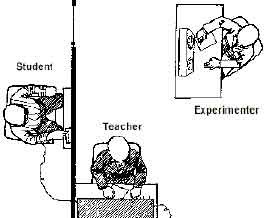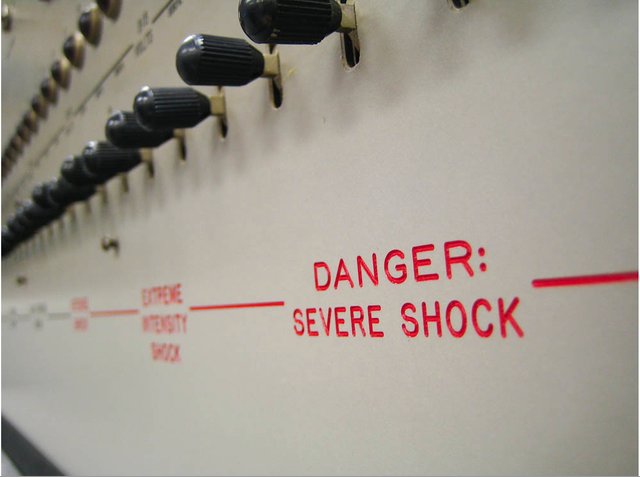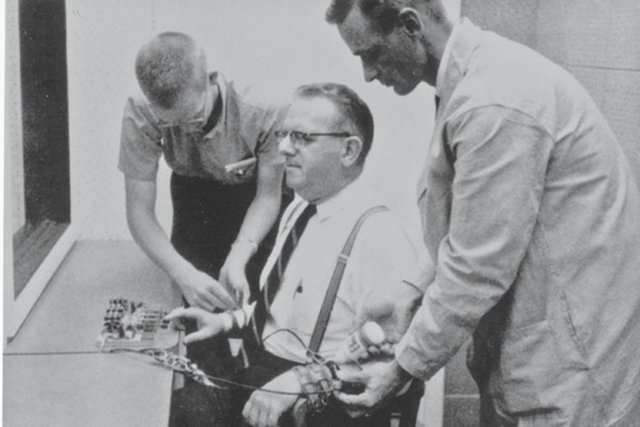Obedience to authority, a psychological experiment that demonstrated the fragility of human values in the face of blind obedience to authority.
Would the human being be capable of committing the most atrocious crimes against humanity only by obedience to authority? This is a question that many scholars have asked themselves throughout the 20th century, especially after having witnessed massive crimes against humanity such as the extermination camps of the Third Reich or the wars between economic powers. Circumstances limit in which violence and death were taken with indifference by an important part of the population.
In fact, researchers have been a good group who have gone a step further and have tried to find the psychological keys that explain why, in certain circumstances, human beings are capable of transgressing our moral values.
Stanley Milgram, author of the test and the criminological relevance of the experiment.
Stanley Milgram was a psychologist at Yale University, who in 1961 conducted a set of experiments whose purpose was to measure the willingness of a participant to obey the orders of an authority, even when these orders could cause a conflict with his system of values and their conscience.

Source
Milgram's idea of carrying out these tests came at the trial of Adolf Eichmann in 1960. Eichmann was sentenced to death in Jerusalem for crimes against humanity during the Nazi regime. He took care of the logistics, planned the collection, transport, and extermination of the Jews. However, at the trial, Eichmann was unabashedly surprised at the hatred shown him by the Jews, claiming that he had only obeyed orders and that obeying orders was a good thing. In his diary, in prison, he wrote: "Orders were the most important thing in my life and I had to obey them without question". Six psychiatrists stated that Eichmann was healthy, that he had a completely normal family life and several witnesses said he was an ordinary person.
Stanley Milgram was very intrigued. Eichmann was a normal name, even boring, that had nothing against the Jews. All this left him with the following questions: What will have led him to participate in the Holocaust? Would it be only for obedience? Could it be that all the other Nazi accomplices only followed orders?

Source
To what extent are we fully aware of the consequences of our actions when we make a hard decision to obey authority? What complex mechanisms intervene in obedience acts that go against our ethics?
The preparation of the Milgram experiment.
Milgram formed a group of a total of 40 volunteers, all men, with ages between 20 and 50 years old and with different types of education, from elementary school to doctorates, which were recruited by mail and by advertisements in the newspaper in which they were invited to be part of an experiment on "memory and learning" so that, by the simple fact of participating, they would be rewarded with a figure of four dollars (equivalent to about 28 current ones) assuring them that they would keep the payment "independently of what will happen after his arrival".
They were informed that three people were needed for the experiment: the researcher (who wore a white coat and served as an authority) the teacher and the student. Volunteers were always assigned by a fake draw the role of teacher, while the role of the student would always be assigned to an accomplice of Milgram. Both teacher and student would be assigned in different but joint rooms, the teacher always observed as the student (who in reality was always the accomplice) was tied to a chair to "avoid involuntary movements" and electrodes were placed while the teacher was assigned in the other room in front of an electric discharge generator with thirty switches that regulated the intensity of the discharge in increments of 15 volts, oscillating between 15 and 450 volts and that, according to the researcher, would provide the indicated discharge to the student.

Source
Milgram also made sure to put labels that indicated the intensity of the discharge (moderate, strong, danger: serious discharge and XXX). The reality was that said generator was false, since it did not provide any type of discharge to the student and only produced sound when the switches were pressed.

The mechanics of the experiment.
The recruited subject or teacher was instructed to teach pairs of words to the apprentice and that, in case he made an error, the student should be punished by applying an electric shock, which would be 15 volts more powerful after each error.

Source
Evidently, the student never received downloads. However, to give realism to the situation facing the participant, after pressing the switch, an audio previously recorded with laments and screams was activated that with each switch increased and became more complaining. If the teacher refused or called the researcher (who was close to him in the same room) he responded with a predefined and somewhat persuasive answer: "Continue please", "Follow please", "The experiment needs you follow ", " It is absolutely essential to continue ", " You have no other choice, you must continue". If after this last sentence the "master" refused to continue, the experiment was stopped. If not, it would stop after it had administered the maximum of 450 volts three times in a row. And in case the subject asked who would take responsibility for what might happen to the student, the experimenter was limited to answer that he was responsible.

Source
Results.
During much of the experiment, many subjects showed signs of tension and anguish when they heard the screams in the next room that were supposedly triggered by the electric shocks. Three subjects had "long and uncontrollable attacks" and although most subjects felt uncomfortable doing so, the forty subjects obeyed up to 300 volts while 25 of the 40 subjects continued to apply shocks up to the maximum level of 450 volts.

Source
This experiment would be considered unethical today but revealed surprising results. Before doing it, psychologists, middle-class people, and students were asked what they thought would happen. Everyone believed that only some sadists would apply the maximum voltage. However, 65% of the subjects reached the end, even when in some recordings the subject complained of having heart problems. The experiment was concluded by the experimenter after three 450 volt discharges. None of the participants flatly refused to give less than 300 volts.
Conclusions extracted by Stanley Milgram.
The conclusions of the experiment to which Milgram arrived can be summarized in the following points:
- When the subject obeys the dictates of the authority, his conscience stops working and there is an abdication of responsibility.
- The subjects are more obedient the less they have contacted the victim and the farther they are physically from it.
- The subjects with authoritarian personality are more obedient than the non-authoritarian ones (classified like this, after an evaluation of fascist tendencies).
- In closer proximity to authority, greater obedience.
- The more academic education, the less intimidation the authority produces, so there is a decrease in obedience.
- People who have received military-type instruction or severe discipline are more likely to obey.
- Young men and women obey equally.
- The subject always tends to justify his inexplicable acts.
Obedience to authority, a principle that would explain institutionalized violence.
The principle of obedience to authority has been defended in our civilizations as one of the pillars on which society is sustained. On a general level, it is obedience to authority that allows the protection of the subject, however, the exacerbated obedience can be a double-edged sword when the so-called discourse of "only obeyed orders" exempts from responsibility and disguises duty impulses sadists.
Before the experiment, some experts hypothesized that only 1% to 3% of individuals would activate the 450-volt switch (and that these subjects would also experience some pathology, psychopathy or sadistic impulses). However, it was ruled out that any of the volunteers they had any pathology, as well as aggressiveness was ruled out as motivation after a series of different tests to volunteers. Seen the data, Milgram postulated two theories to try to explain the phenomena.
First theory (Conformity with the group).
The first based on the works of conformity of Asch, states that a subject who does not have the skill or knowledge to make decisions, (particularly in a crisis) will transfer decisions to the group.
Second theory (The reification).
The second theory, more widely accepted is known as reification, and refers to the essence of obedience is that the person is perceived only as an instrument for the realization of the wishes of the other person and therefore, is not considered as responsible for their actions. Thus this "transformation" of self-perception occurred, all the essential characteristics of obedience occur.
An experiment that marked a before and after in social psychology.
The Milgram experiment represents one of the social psychology experiments of greatest interest to criminology when it comes to demonstrating the fragility of human values in the face of blind obedience to authority.
Their results showed that ordinary people, at the command of a figure with only a little authority, are capable of acting cruelly. In this way, criminology has managed to understand how some criminals who have committed savage genocides and terrorist attacks have developed a very high level of obedience to what they consider to be an authority.
References.
- Obedience to Authority: An Experimental View, by Stanley Milgram.
- https://www.simplypsychology.org/milgram.html
- http://www.age-of-the-sage.org/psychology/milgram_obedience_experiment.html
- http://www.open.edu/openlearn/ocw/mod/oucontent/view.php?printable=1&id=18956
- https://explorable.com/stanley-milgram-experiment
- https://www.commentarymagazine.com/articles/obedience-to-authority-by-stanley-milgram/
- https://www.commonlit.org/texts/the-milgram-experiment
- https://www.verywellmind.com/the-milgram-obedience-experiment-2795243
If you want to read more scientific articles of good quality, do not waste your time, and visit the hashtag #steemstem.
Disclaimer: All the images used are correctly labeled for reuse.
